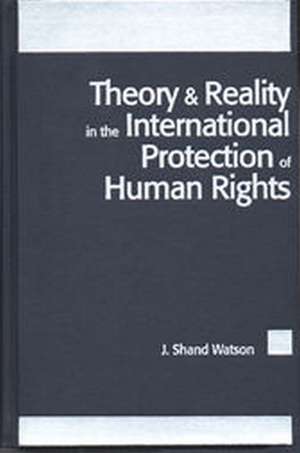Theory and Reality in the International Protection of Human Rights
Autor Watsonen Limba Engleză Hardback – 28 feb 1999
Theory and Reality in the International Protection of Human Rights presents a defense of the traditional theory of international law-based on a decentralized nation-state system of international relation—as being more appropriate for the analysis of its subject than more recent variants that allow for supranational redress at an increasingly personal level. In particular, Professor Watson shows how the proponents of the international human rights regime persistently use a legislative mode of reasoning, and how international law cannot sustain this technique. He holds that violation of the right to life is best adjudicated within a customary system, and concludes that the validity of the norms of international human rights has yet to be demonstrated.
Published under the Transnational Publishers imprint.
Preț: 837.01 lei
Preț vechi: 1020.75 lei
-18% Nou
Puncte Express: 1256
Preț estimativ în valută:
160.17€ • 167.78$ • 132.74£
160.17€ • 167.78$ • 132.74£
Carte indisponibilă temporar
Doresc să fiu notificat când acest titlu va fi disponibil:
Se trimite...
Preluare comenzi: 021 569.72.76
Specificații
ISBN-13: 9781571050977
ISBN-10: 1571050973
Pagini: 340
Dimensiuni: 159 x 235 x 32 mm
Greutate: 0.7 kg
Editura: Brill
Colecția Brill | Nijhoff
ISBN-10: 1571050973
Pagini: 340
Dimensiuni: 159 x 235 x 32 mm
Greutate: 0.7 kg
Editura: Brill
Colecția Brill | Nijhoff
Notă biografică
J. Shand Watson is Professor of Law at Mercer University.
Recenzii
For many years proponents of “human rights” have tried to convince statesmen that the moral imperatives that underlie the concept of “human rights” require enforcement by international legal order. But statesmen of sound moral convictions and humanitarian bent seem more inclined to use polemics to condemn the trespasses of others than to support the international institutions that might really transfer the moral imperatives into “law.” In this book, Professor Watson clearly and forcefully explains why.
Alfred P. Rubin,
Fletcher School of Law and Diplomacy
Alfred P. Rubin,
Fletcher School of Law and Diplomacy
Cuprins
Acknowledgments; Preface; Chapter I. The Gap Between Theory and Reality; Chapter II. State Practice and Consent in the Choice of Legal Theory; Chapter III. Coercion, and the Motivation to Comply with Human Rights Norms; Chapter IV. Custom as the True Practice of States; Chapter V. General Assembly Resolutions as a Source of Human Rights; Chapter VI. Treaties, Obligation, and Nonenforcement; Chapter VII. Subsidiary Sources; Chapter VIII. Domestic Jurisdiction versus International Jurisdiction; Chapter IX. Humanitarian Intervention and
Nonenforcement; Chapter X. The Role of Natural Law and Natural Rights; Chapter XI. The Efficacy of Domestic Secondary Norms; Index
Nonenforcement; Chapter X. The Role of Natural Law and Natural Rights; Chapter XI. The Efficacy of Domestic Secondary Norms; Index
